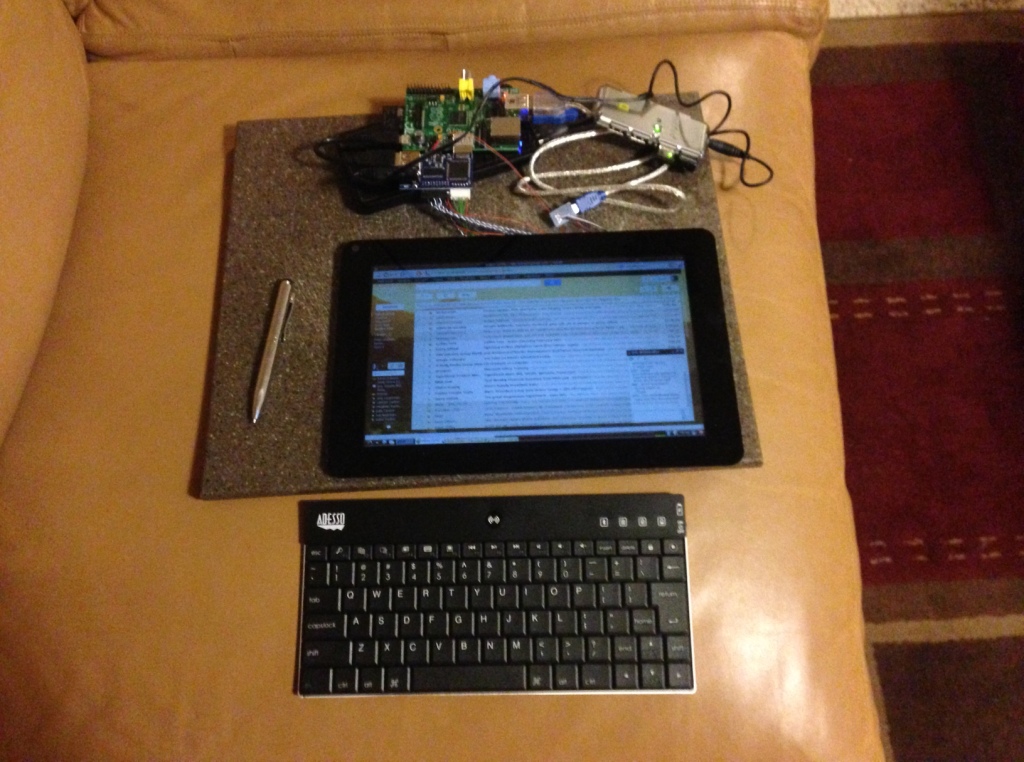PiPad Prototype
It looks like a bit of a mess right now, but this is the makings of a DIY tablet computer using the Raspberry Pi. I originally got the idea from fellow Make blogger Adam Flaherty and was thinking about pursuing it as a potential kit for the Maker Shed. Unfortunately I couldn’t source the parts at a low enough price. Of course, that wasn’t going to stop me from building it myself! In the picture I’m logged into my Gmail account using Google Chat to talk to Eric Weinhoffer, the Product Development Engineer in the Maker Shed. Here’s what I’m using:
- 10″ Capacitive Touch Screen with LDVI Adapter from Chalk-Elec.com. I highly recommend this company even if they are based in Malaysia.
- Monoprice Wifi Adapter
- Anker Astro3E 10,000mAh battery – Puts out 3A @ 5V! Gives me about 6hrs of battery life.
- IOGear Micro Powered USB Hub – I might switch to a Belkin one in the final version.
- Azio Bluetooth Dongle – Mine is an older version that I had laying around. This one should work too.
- Adesso Bluetooth Mini Keyboard – Super thin and compact without being too cramped to type.
- Raspberry Pi Model B – Running Raspbian Wheezy.
- Custom hacked USB cable to power the LDVI adapter and hub. It’s not pretty but it works. I’ll probably have to redesign it later and make it more compact before fitting it into the enclosure. The plugs and cables take up too much room.
Here are the programs I installed using Apt-Get:
- matchbox-keyboard – Onscreen keyboard. Works great with the touchscreen but moves the icons around when active. Weird.
- bluetooth bluez-utils blueman – I followed this tutorial then used the GUI to set up the keyboard.
I’m very happy with this overall. Yes, I could have bought an Android tablet or even an iPad Mini for the same price but what’s the fun of that? Next up, I need an enclosure. I’m thinking of using baltic birch plywood and putting using carbon fiber for the back, just for extra sex appeal. The plan is to expose some USB ports, the SD Card slot (so I can swap in Raspbmc) and the GPIO using a cable. Now I just need the time to sit down and CAD the whole thing up. Updates to follow!



Hello mike you are doing a really great job!! I was looking to build a tablet myself and was wandering if i could use the 7″ lcd touchscreen display sold by sain smart http://www.sainsmart.com/sainsmart-7-digital-lcd-800-480-black-for-raspberry-pi.html
Your reply will be well appreciated. Thank you.
That should work but the one you linked to doesn’t have a touchscreen. This one does though. You’ll will to pay attention to the power requirements. The SainSmart screens need 12V so you won’t be able to power it from a cellphone backup battery like I did without a step-up converter. Chances are that a 3S LiPo battery will do (11.1V) but you’ll need a regulator to supply 5V to the Pi and USB hub.
Thank you very much! what are the external memory options. do i need an SD sheild to be able to read an sd card. i want to make a video demo for my students with this home built pipad. Thank you
Hey Michael:
My name is Debosmit and I am a undergraduate student at the University of Washington, Seattle. I’m currently working on a similar project and would love to hear about your experiences in making this product, regarding what problems you faced, etc.
It would be great if you could provide me with an email ID that I can reach you at.
Hope to hear from you soon.
Best,
Debosmit
Michael Castor
I was lucky to come across your site – How I Built a Raspberry Pi Tablet and was surprised to learn that one can build a Tablet at home using Raspberry Pi motherboard.and other components.
I am from Bangalore (India) and interested to build the tablet but it is very difficult to import the components from Maker Shed.
Are there any sources in India where these components can be purchased?
Waiting for your reply
A. S. Bhasker Raj
email ID: bhasker.raj48@gmail.com
Bangalore
India
Mobile: +919590150505
Hello,
I have never been to India but all you’d really need for the foundation would be a Raspberry Pi, a compatible 5V touchscreen (I think this one is used in a Samsung tablet) with LVDS adapter and a mobile phone charger.